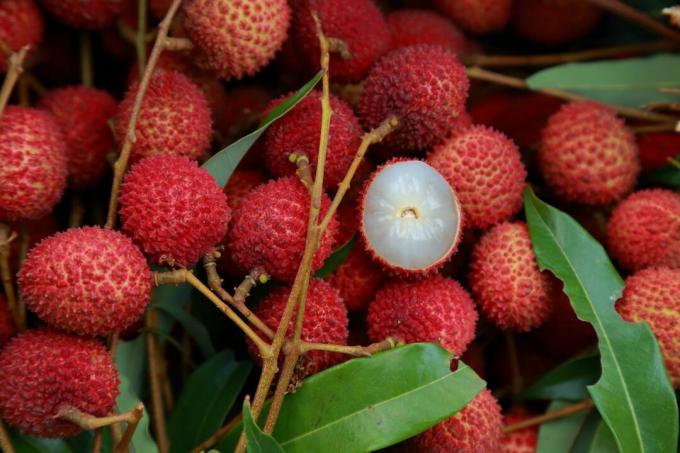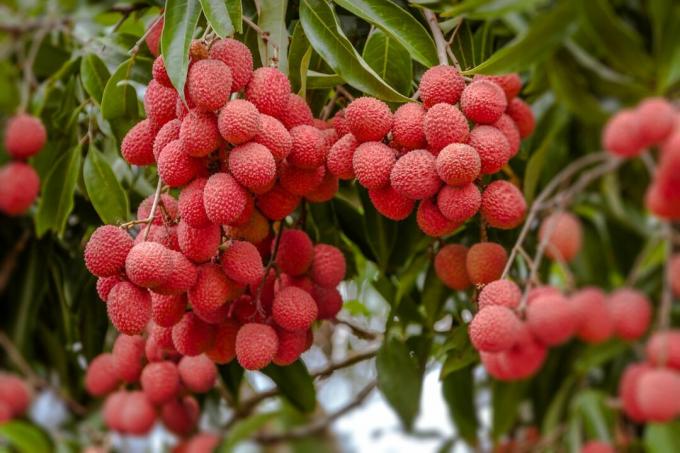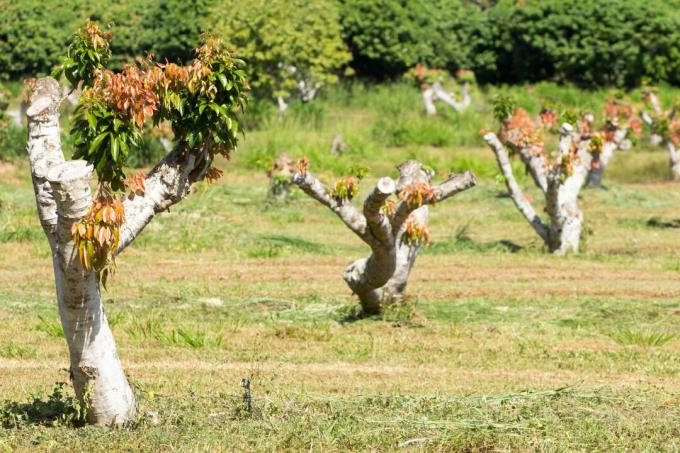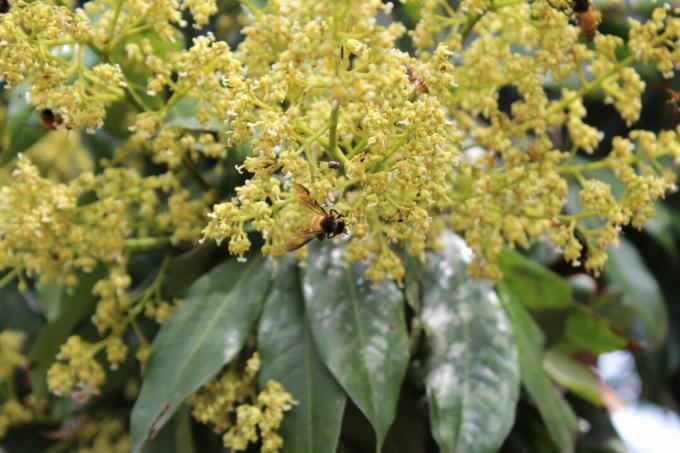The exotic looking lychee fruits are sold in supermarkets and delicatessens. However, if you also want to grow them in your own garden, you will take on a challenge for your green fingers. You can find out here how cultivation and care can be successful.

Lychees from your own garden? Why not! The lychee tree can be cultivated in a greenhouse or bright conservatory and develops its sweet fruits in summer. They are not only delicious, but also rich in vitamin C.
"Contents"
- Lychee tree: origin, flowering and properties
- Plant a lychee tree
-
multiply lychees
- Plant lychees
- cut cuttings
- moss
-
The most important care measures
- Watering the lychee tree
- Fertilize lychee tree
- Cut lychee tree
- Repot lychee tree
- Is the lychee tree hardy?
- Harvesting and using lychees
Lychee tree: origin, flowering and properties
The lychee tree (Lychee chinensis) comes from the soap tree family (Sapindaceae) and is the only species of the plant genus
lychee. The plant originally comes from the river basins and tropics of southern China and northern Vietnam, where it has been cultivated for more than 1000 years. Today, lychees are also grown in Southeast Asia, Africa, Israel, Australia and the southern United States. As a tree, it reaches a height of 10 to 15 meters in its natural habitat. In spring, the lychee tree develops small, inconspicuous yellowish-green flowers. These form a terminal, hanging panicle that is about 30 centimeters long. Between 2 and 20 fruits form on an inflorescence, which are ripe after about 60 to 80 days. Then the fruit, which is about three centimeters thick, is surrounded by a red shell that consists of many small pentagonal parts. The peel of the fruit is easy to remove, revealing a white, gelatinous pulp. This is sweet and rich in vitamin C and potassium. A reddish-brown core is embedded in the pulp. In order to be able to harvest lychee fruits in Germany, the tree must be in an air-conditioned greenhouse all year round. There it is important to plant it freely in the ground, fruiting in the bucket is not possible. Lychees are also known as Chinese hazelnuts or love fruit. By the way, the lychee tree keeps its green leaves even in winter, because it is an evergreen plant.
Plant a lychee tree
If you want to decorate your greenhouse or conservatory with a lychee tree, you can buy a tree that has already been planted or grow a lychee tree from a lychee core.
In our latitudes, the lychee tree can only be cultivated in the form of potted plants or in a heated greenhouse. Since it requires high humidity and warm temperatures, a greenhouse or conservatory is also required. The lychee tree should be planted in a coarse-grained substrate - a humus-rich, sandy to loamy substrate mixed with expanded clay or lava granules is suitable. The humus soil stores water and nutrients, the expanded clay or lava granules ensure a loose and airy soil environment that is also well permeable to water. The pH of the substrate should be between 5.5 and 6.5. Our Plantura organic universal soil is a good example of such an earth. It offers the appropriate physical properties and, as a peat-free variant, is also very environmentally friendly. Mixed with expanded clay or lava granules, it is ideal for cultivating a lychee tree.
In summer, the lychee tree can also be placed outdoors in a sheltered, sunny and warm place.
Tip: Not only lychees can be grown from the seeds of purchased fruit. In our book "Regrow your veggies“ we will show you how you can plant avocado or mango seeds, among other things.
multiply lychees
If you want to propagate your lychee tree, you have several options: You can propagate lychees using seeds and cuttings, or try mossing.
Plant lychees
Lychee kernels don't have to end up as a waste product in the compost, because they are ideal for growing a lychee tree. Seeds of fully ripened lychee fruits have good germination success. The pulp must first be carefully removed from them, and then the clean core is pickled. To do this, it is placed in a water bath at 50 °C for 20 minutes. After the core has been released, it can germinate for about four to five days, which is why it should be planted as soon as possible. Then you can plant it in potting soil. A potting soil that is not as heavily fertilized as normal potting soil is suitable. This results in increased root growth of the young plants, which ensures a strong tree. Our Plantura, for example, is suitable Organic herbal & seed soil, which at the same time protects the environment as a peat-free variant.

The core is placed horizontally two to three centimeters under the potting soil, then the substrate is pressed. In order for the core to germinate, it needs a temperature of 25 °C. A warm, partially shaded place is beneficial for germination. The first germs appear about two weeks later. After the first four leaves have formed, the seedlings can be transplanted into larger containers. Do not remove the core when repotting, as it supplies the small shoot with nutrients.
Tip: To increase the humidity and temperature in the growing pot, a film can be stretched over the pot. It looks like a mini greenhouse. But don't forget to air it from time to time - otherwise mold will be greatly encouraged.

cut cuttings
The lychee tree can be propagated by cuttings. For this purpose, a young shoot is cut off from a mother plant with a sharp knife. It is important to ensure that there is a bud on the upper and lower side of the shoot. The shoot is then defoliated, only two leaves should remain on the top of the shoot. These two sheets are then cut off in half. So that the cutting can form roots, it is placed in a glass of water. If the roots are big enough, the cuttings can be planted.
moss
The lychee tree can also be propagated with moss. To do this, a strip of bark about ten centimeters long is removed from a young shoot at the end of April. A bag with watered peat moss is then pulled over this strip of bark and fixed with adhesive tape. After six to eight weeks, new roots form from the strip of bark and spread through the moss. Then the branch can be removed from the mother plant and planted.

The most important care measures
To ensure good plant growth, lychee trees require some care. You can find out everything you need to know about this below.
Watering the lychee tree
In the spring you should avoid heavy watering, because drought promotes the formation of flowers. However, after flowering, the lychee tree needs heavy watering, otherwise the fruit will drop prematurely. For even soil moisture, you can completely flood the root ball with water and then let it dry a little. The root ball should then be kept constantly moist, but waterlogging should be avoided. The soft foliage and small pinnate leaves of the lychee tree also require a humidity level of over 70%. To increase humidity, you can put bowls of water in the summer or spray the plants with water. During the winter break, however, the heavy watering should be stopped.
Fertilize lychee tree
The lychee tree does not need much fertilizer. However, you should not completely neglect fertilization. From April to September, a liquid fertilizer should be applied every 10 to 14 days. This supports the tree during its growth period and the development of the sweet fruit. An organic fertilizer such as ours is ideal Organic citrus & Mediterranean fertilizer. This contains iron chelates, which prevent iron deficiency and leaf chlorosis.
Tip: Stick to the specified fertilizer times, because the lychee tree is sensitive to salt. Over-fertilization leads to soil salination and root damage. This can be recognized by the brown leaf edges. To avoid such damage, only organic fertilizer should be applied.
Cut lychee tree
It is not necessary to cut back the lychee tree. However, if individual shoots become too long, they can be shortened in March or April.

Repot lychee tree
Every two to three years, the lychee tree should be transplanted into a larger pot.
Tip: The lychee tree grows very slowly. Avoid planting the lychee tree in a large pot from the start - then you can repot more comfortably.
Is the lychee tree hardy?
Lychee trees are not hardy in this country and have to hibernate at temperatures of 5 to 15 °C. However, in order for the tree to flower, the lychee tree must be exposed to temperatures of 0 to 12 °C for about ten days. Then it can be set up a little warmer again. For hibernation, you should choose a frost-free, bright location with high humidity. Overwintering in bright living rooms is also possible, but is less conducive to the vitality of the plant.

Harvesting and using lychees
Lychees do not ripen after harvest. This means that the harvest must be planned precisely. When the lychees swell and the bumps on the skin flatten out, the red fruits are ready to be harvested. A taste test should be carried out regularly to determine when the ripening time is optimal. Lychees mature at different speeds, which is why you should harvest them every three to four days. For harvesting, the entire panicles are removed with pruning shears, you can only remove individual lychees to try them out. Once the lychees have been harvested, they can be eaten fresh, stored or processed. Lychees can be stored for about three to five days at room temperature and about three months in the refrigerator.

Lychees can be pickled in sugar and preserved or dried. In Asia, the dried fruit is served with tea. The freshly squeezed juice can either be drunk or processed into liqueur and wine.
If you are looking for local exotics, we will be happy to provide you with them loganberry before, which, in contrast to the tropical fruits, does not require a greenhouse.
